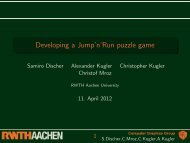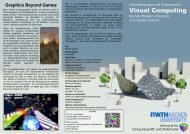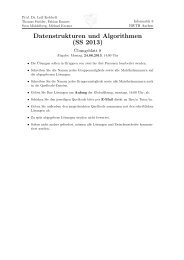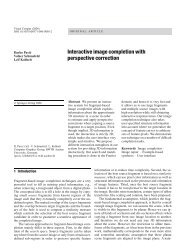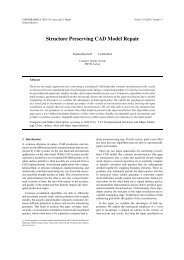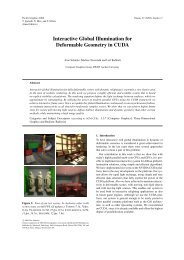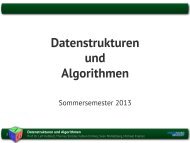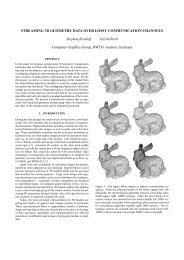sqrt(3) subdivision - Computer Graphics Group at RWTH Aachen
sqrt(3) subdivision - Computer Graphics Group at RWTH Aachen
sqrt(3) subdivision - Computer Graphics Group at RWTH Aachen
Create successful ePaper yourself
Turn your PDF publications into a flip-book with our unique Google optimized e-Paper software.
Figure 3: The ¢ 3-<strong>subdivision</strong> gener<strong>at</strong>es semi-regular meshes since all new vertices have valence six. After an even number 2k of refinement<br />
steps, each original triangle is replaced by a regular p<strong>at</strong>ch with 9 k triangles.<br />
By definition, the <strong>subdivision</strong> m<strong>at</strong>rix is a square m<strong>at</strong>rix S which<br />
maps a certain sub-mesh V ¦ M k to a topologically equivalent submesh<br />
S£ V¥ ¦ M k 1 of the refined mesh. Every row of this m<strong>at</strong>rix is<br />
a rule to compute the position of a new vertex. Every column of this<br />
m<strong>at</strong>rix tells how one old vertex contributes to the vertex positions<br />
in the refined mesh. Usually, V is chosen to be the neighborhood of<br />
a particular vertex, e.g., a vertex p and its neighbors up to the k-th<br />
order (k-ring neighborhood).<br />
To derive the weight coefficients for the new <strong>subdivision</strong> scheme,<br />
we use these criteria for some kind of reverse engineering process,<br />
i.e., instead of analyzing a given scheme, we derive one which by<br />
construction s<strong>at</strong>isifies the known necessary criteria. The justific<strong>at</strong>ion<br />
for doing this is th<strong>at</strong> if the necessary conditions uniquely determine<br />
a smoothing rule then the resulting <strong>subdivision</strong> scheme is the<br />
only scheme (with the given stencil) th<strong>at</strong> is worth being considered.<br />
In the Appendix we will give the details of the sufficient part of the<br />
convergence analysis.<br />
Since the ¢ 3-<strong>subdivision</strong> oper<strong>at</strong>or inserts a new vertex for every<br />
triangle of the given mesh, the minimum stencil for the corresponding<br />
smoothing rule has to include <strong>at</strong> least the three (old) corner<br />
vertices of th<strong>at</strong> triangle. For symmetry reasons, the only reasonable<br />
choice for th<strong>at</strong> smoothing rule is hence<br />
p<br />
Figure 4: The applic<strong>at</strong>ion of the <strong>subdivision</strong> m<strong>at</strong>rix S causes a rot<strong>at</strong>ion<br />
around p since the neighboring vertices are replaced by the<br />
centers of the adjacent triangles.<br />
u v v v <br />
p¤ p 0 ¤¨§¨§¨§©¤ p n¥1we derive the <strong>subdivision</strong> m<strong>at</strong>rix<br />
v<br />
p<br />
i<br />
: 1<br />
q p<br />
3¡p i¢<br />
p j¢<br />
¤ (1)<br />
k£<br />
i.e., the new vertex q is simply inserted <strong>at</strong> the center of the triangle<br />
£ p i ¤ p j ¤ p k ¥ .<br />
The smallest non-trivial stencil for the relax<strong>at</strong>ion of the old vertices<br />
is the 1-ring neighborhood containing the vertex itself and its<br />
direct neighbors. To establish symmetry, we assign the same weight<br />
to each neighbor. Let p be a vertex with valence n and p<br />
¤<br />
0 p ¤¨§¨§¨§©¤ n¥1<br />
its directly adjacent neighbors in the unrefined mesh then we define<br />
1 n¥1<br />
n<br />
n<br />
∑ p i (2) §<br />
i§0<br />
p¥ £ S£ α : n α ¥<br />
The remaining question is wh<strong>at</strong> the optimal choice for the parameter<br />
α<br />
1¦ p¢<br />
n would be. Usually, the coefficient depends on the valence<br />
of p in order to make the <strong>subdivision</strong> scheme applicable to control<br />
meshes M 0 with arbitrary connectivity.<br />
The rules (1) and (2) imply th<strong>at</strong> the 1-ring neighborhood of<br />
a vertex S£ p¥ ¦ M k 1 only depends on the 1-ring neighborhood<br />
of the corresponding vertex p ¦ M k .<br />
Hence, we can set-up a<br />
£ £ m<strong>at</strong>rix 1¥ which maps p and its n neighbors to<br />
the next refinement level. Arranging all the vertices in a vector<br />
n¢ 1¥©¨ n¢<br />
S 1<br />
3<br />
<br />
<br />
1 1 1 0 <br />
1 0 . . . . .. . ..<br />
. ..<br />
.<br />
.<br />
. .. . .. . .. 0<br />
.<br />
1 0 .. . .. 1<br />
0 1<br />
1 1 0 <br />
with 3£ u α n ¥ and v 3α nn. However, when analysing the<br />
eigenstructure of this m<strong>at</strong>rix, we find th<strong>at</strong> it is not suitable for the<br />
construction of a convergent <strong>subdivision</strong> scheme. The reason for<br />
this defect is the rot<strong>at</strong>ion around p which is caused by the applic<strong>at</strong>ion<br />
of S and which makes all eigenvalues of S complex. Fig. 4<br />
depicts the situ<strong>at</strong>ion.<br />
From the last section we know th<strong>at</strong> applying the<br />
1¦<br />
3-<strong>subdivision</strong> ¢<br />
oper<strong>at</strong>or two times corresponds to a tri-adic split. So instead of<br />
analysing one single <strong>subdivision</strong> step, we can combine two successive<br />
steps since after the second applic<strong>at</strong>ion of S, the neighborhood<br />
of S 2 p¥ is again aligned to the original configur<strong>at</strong>ion around p.<br />
£<br />
Hence, the back-rot<strong>at</strong>ion can be written as a simple permut<strong>at</strong>ion<br />
m<strong>at</strong>rix<br />
R <br />
<br />
<br />
1 0<br />
0 0 0<br />
1<br />
0<br />
0<br />
0 1 . . . 0<br />
.<br />
. .. . .. . ..<br />
. ..<br />
0 1 0<br />
0<br />
<br />
§<br />
<br />
The resulting m<strong>at</strong>rixS RS 2 now has the correct eigenstructure for<br />
<br />
<br />
(3)<br />
0



